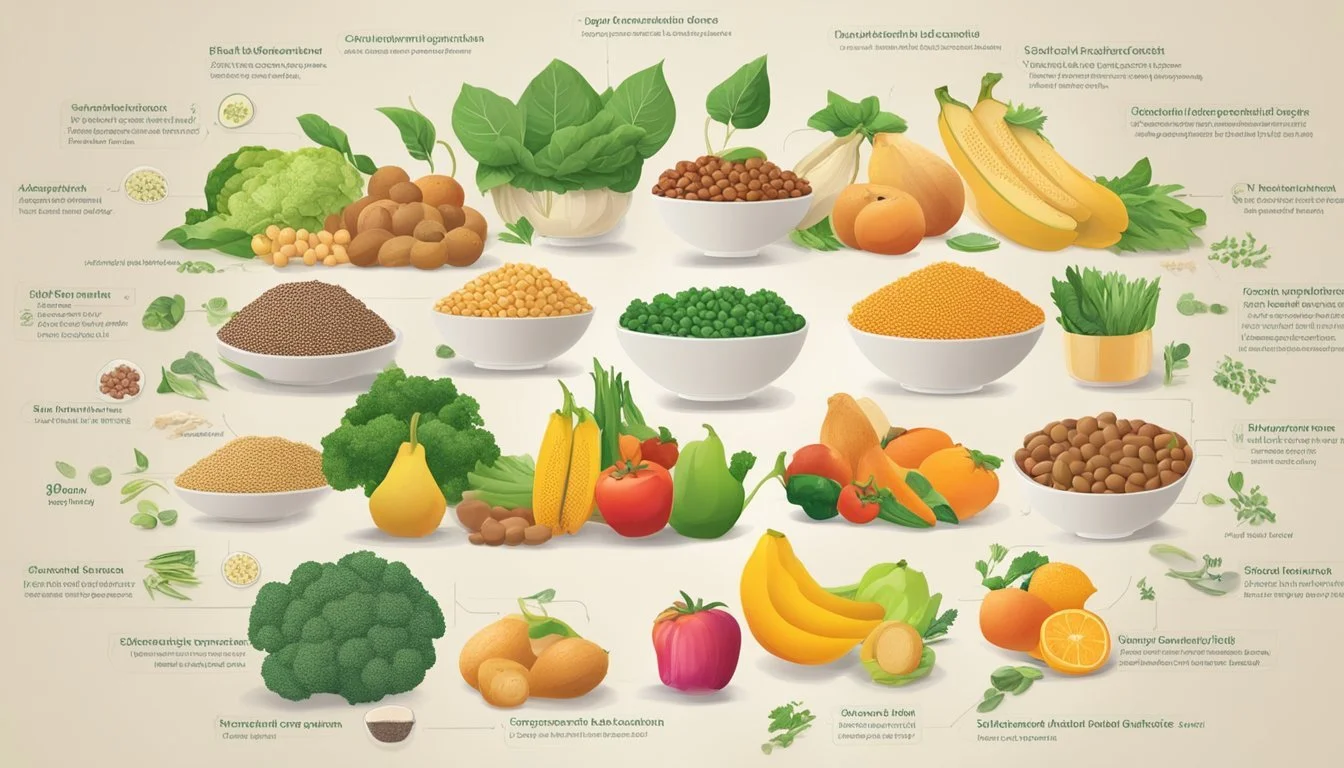The Truth About the Flexitarian Diet
Evaluating Its Balance in Plant-Based Eating
The Flexitarian diet emerges as a middle ground in the evolving landscape of dietary choices, advocating a plant-based eating pattern without fully renouncing meat and other animal products. Characterized by its flexibility, this diet allows individuals to reap the benefits of vegetarianism while accommodating the occasional consumption of meat. Proponents argue that a flexitarian approach can lead to improved health outcomes, such as lower blood pressure and a reduced risk of certain diseases, without the strict exclusions that define veganism or vegetarianism.
Central to the flexitarian diet is the predominance of plants in one's nutritional regimen, incorporating a variety of fruits, vegetables, legumes, and whole grains. The diet encourages a balanced approach to eating, where plant proteins play a starring role and meat acts as a supporting character, included with intention rather than as a staple. This flexibility facilitates a gradual transition for those aiming to shift from a meat-heavy diet to one that is largely plant-based, making it a sustainable choice for many.
The idea that the flexitarian diet may not qualify as plant-based is a misconception held by some, as the diet’s core principles clearly support a predominantly plant-oriented lifestyle with moderate allowances. This inclusiveness and adaptability make the flexitarian diet a practical and appealing option for those looking to improve their dietary habits without adhering to strict rules or complete food group eliminations.
Defining the Flexitarian Diet
The Flexitarian Diet merges flexibility with vegetarian principles, enabling individuals to reap the benefits of plant-based eating without completely eliminating meat. By incorporating occasional animal products, it differs significantly from strict vegetarian or vegan diets.
Origins and Principles
The term "flexitarian" was popularized by dietitian Dawn Jackson Blatner in her 2009 book to describe an eating style that is primarily plant-based but occasionally includes meat and other animal products. The core principles of the Flexitarian Diet include:
Increased intake of plant foods: fruits, vegetables, legumes, and whole grains are foundational.
Moderation in animal products: meat and other animal products are consumed on an infrequent basis.
Emphasis on natural, less processed foods: processed meats and high-sugar snacks are limited.
This approach is not only intended to improve health but also to reduce the environmental impact of traditional meat-heavy diets.
Comparing Flexitarian to Other Diets
When contrasting the Flexitarian Diet with other plant-based eating patterns, key differences emerge:
Vegetarian Diet: Completely excludes meat, fish, and poultry; however, it includes dairy and eggs.
Vegan Diet: Excludes all animal products, including dairy, eggs, and honey.
Diet Type Animal Meat Dairy Products Eggs Seafood Highly Processed Foods Flexitarian Rarely Yes* Yes* Rarely Limited Vegetarian No Yes Yes No No Standard Vegan No No No No Limited
*Flexitarians tend towards moderation but may include these products more frequently than a traditional vegetarian.
The Flexitarian Diet is distinguished by its lack of strict rules and its adaptability, making it a semi-vegetarian practice that can be appealing for those looking to transition towards plant-based eating without committing to a complete exclusion of animal products.
Nutritional Benefits of Flexitarianism
The Flexitarian diet merges the benefits of vegetarian eating with the flexibility of enjoying animal products in moderation. By emphasizing plant-based foods while not excluding meat, it offers a diverse range of nutrients essential for health.
Macro and Micronutrient Overview
Protein: A cornerstone of the Flexitarian diet is plant proteins such as beans, lentils, and peas. They provide essential amino acids, and when paired with whole grains like quinoa, (What wine goes well with quinoa?) they offer a complete protein profile.
Fiber: Plant-based components of the diet are rich in fiber, crucial for maintaining digestive health.
Vitamins and Minerals: This diet is high in vitamins A, C, and E, along with minerals such as magnesium and potassium found in a variety of fruits, vegetables, nuts, and seeds.
Fats: Flexitarians typically consume heart-healthy fats from sources like avocados, olive oil, and nuts, which contribute to overall nutrient density.
Health Benefits and Disease Prevention
Heart Disease: The high fiber and healthy fat content can help reduce cholesterol levels, thereby potentially lowering the risk of heart disease.
Type 2 Diabetes: A Flexitarian diet rich in plant-based foods may improve blood sugar control, reducing the risk of developing type 2 diabetes.
Cancer: Diets high in fruits, vegetables, and fiber have been associated with a decreased risk of certain types of cancer.
Nutrients: This dietary approach ensures an intake of a broad array of nutrients necessary to support good health, predominantly through a higher consumption of fruits and vegetables which boast a wide spectrum of vitamins and minerals.
Flexitarian Diet Components
The Flexitarian Diet merges vegetarian eating patterns with the flexibility to include animal protein. Its balanced approach allows for a diverse intake of foods while focusing on plant-based nutrition.
Proteins: Plant-Based and Animal Sources
Proteins in the Flexitarian Diet come from both plant-based and animal sources, promoting variety and balance. Plant-based proteins include beans, peas, lentils, nuts, and seeds, which are core to this diet. These options are not only high in protein but also fiber and other key nutrients. On the other hand, animal protein is consumed in moderation, with a focus on lean meats, fish, and poultry to decrease saturated fat intake and optimize health benefits.
The Role of Fruits, Vegetables, and Whole Grains
A cornerstone of the Flexitarian Diet is the high intake of fruits and vegetables, providing essential vitamins, minerals, and fiber. It emphasizes variety, encouraging consumption of all colors of the produce rainbow. Whole grains such as quinoa, brown rice, and barley are also integral, as they offer fiber, B vitamins, and substantial energy; they serve as a staple in meals, ensuring a balanced and satiating diet.
Including Dairy and Eggs in Moderation
Dairy and eggs are permitted in the Flexitarian Diet, contributing valuable nutrients like calcium, vitamin D, and high-quality protein. They are included mindfully, with emphasis on moderation and portion control. Dairy options include milk, cheese, and yogurt, while eggs can be used in a variety of dishes. Plant-based alternatives to dairy are also widely used among flexitarians, catering to those who prefer non-dairy options.
Environmental Impact of a Flexitarian Lifestyle
Adopting a flexitarian lifestyle contributes to environmental sustainability by scaling down meat consumption. It strategically targets the reduction of carbon footprint and greenhouse gas emissions associated with traditional meat-based diets.
Reducing Meat Consumption for the Planet
When individuals reduce their meat intake, it directly correlates with a decrease in the demand for livestock production. Livestock farming is recognized as a significant contributor to environmental concerns due to deforestation, overconsumption of water, and the reduction of biodiversity. A shift towards a flexitarian diet, which emphasizes plant-based foods with occasional meat consumption, can lead to:
A substantial decrease in water usage, as plant cultivation generally requires less water than animal farming.
Preservation of biodiversity by reducing the need for large-scale monocultures associated with feed production for livestock.
Carbon Footprint and Greenhouse Gas Emissions
Greenhouse gas emissions from the meat industry are notably high, primarily due to methane produced by ruminant animals like cattle. The adoption of a flexitarian diet can reduce these emissions. Key points include:
Methane emissions are significantly lower in plant-based agriculture compared to livestock farming.
Carbon dioxide emissions associated with transportation and processing of meat products are curtailed when the consumption of meat is reduced.
The flexitarian approach aligns with a smaller environmental impact, positioning it as a balanced compromise between nutritional needs and the health of the planet.
Daily Flexitarian Eating Patterns
The Flexitarian Diet merges vegetarian eating principles with the occasional inclusion of meat. It emphasizes plant-based foods while maintaining the flexibility to enjoy animal proteins in moderation.
Sample Meal Plans and Food Groups
Plants take center stage in the Flexitarian Diet, with a focus on incorporating fruits, vegetables, legumes, and whole grains into daily meals. Legumes such as beans and lentils, and nuts are excellent sources of plant-based proteins and can be included in a variety of dishes.
A day's eating pattern might include:
Breakfast: Oatmeal with nuts and fresh fruit.
Lunch: Quinoa salad with chickpeas, mixed greens, and a variety of colorful vegetables.
Dinner: Stir-fried tofu or tempeh with a medley of vegetables served over brown rice.
Incorporating a variety of food groups, ensures intake of essential nutrients.
Understanding Flexitarian Portion Sizes
Portion sizes in a Flexitarian Diet are guided by the principles of balance and moderation. The diet suggests filling half of one's plate with vegetables and fruits, a quarter with whole grains, and the remaining quarter with plant-based or animal proteins. Here is a breakdown of a balanced plate:
Half plate: Vegetables and fruits
Quarter plate: Whole grains such as brown rice or whole-grain pasta
Quarter plate: Plant-based proteins like beans, or a moderate portion of animal protein
Monitoring portion sizes helps manage calories and supports a balanced diet. With its emphasis on plants and variety, the Flexitarian Diet promotes a balance allowing for nutritional adequacy and personal preferences.
Challenges and Considerations
When adopting the Flexitarian diet, individuals must remain vigilant to maintain a nutritionally complete diet and must manage societal and dining pressures that could potentially affect adherence.
Addressing Potential Nutritional Deficiencies
Individuals following a Flexitarian diet may be at risk of certain nutritional deficiencies. A key concern is obtaining adequate vitamin B12, which is primarily found in animal products and is essential for nerve function and the production of DNA and red blood cells. It is important for Flexitarians to consider fortified foods or supplements to meet their B12 needs. Similarly, nutrients like calcium and zinc, often less abundant in plant-based foods, need attention. Consuming a variety of vegetables, legumes, nuts, and seeds can help maintain the necessary levels of these nutrients.
Protein sources are another consideration. While animal products are not excluded from this diet, they are limited. Therefore, Flexitarians should incorporate a variety of plant-based proteins such as beans, lentils, tofu, and quinoa to ensure a dietary balance. This approach can help meet protein requirements as well as provide a range of other nutrients necessary for good health.
Navigating Social Situations and Dining Out
Flexitarians may find social situations and dining out challenging, as many social gatherings revolve around food, often with limited plant-based options. When dining out, restaurants may not always provide menu items that fit a Flexitarian dietary pattern. It can be beneficial for Flexitarians to review menus ahead of time and communicate with restaurant staff about their dietary preferences to ensure they can still enjoy socializing without compromising their eating habits. Additionally, hosting gatherings where one can control the menu or bringing a suitable dish can help Flexitarians stay on track with their diet while engaging in social situations.
How to Transition to a Flexitarian Diet
Transitioning to a flexitarian diet involves slowly increasing plant-based foods in one's diet while reducing meat consumption. This gradual change, coupled with mindful meal planning, creates the foundation for a sustainable, semi-vegetarian lifestyle that supports balanced nutrition.
Setting Achievable Goals
One should start by defining clear, manageable objectives. For example:
Week 1: Choose two days to go meatless.
Week 2-3: Increase to three meatless days and incorporate plant-based proteins.
Week 4: Evaluate progress and set new goals, like reducing red meat intake.
By setting such goals, individuals can ease into the diet without feeling overwhelmed, supporting adherence to this healthy eating pattern.
Incorporating Variety in Meal Planning
Balance: Each meal should consist of roughly 50% fruits and vegetables, 25% whole grains, and 25% protein, predominantly from plant sources.
Nutrition: Include a diverse range of plant proteins, such as beans, lentils, tofu, and edamame, to meet dietary needs.
Meal Ideas:
Monday: Quinoa salad with black beans, corn, and avocado.
Friday: Stir-fried tofu with mixed vegetables and brown rice.
Offering variety in meal options can prevent boredom and ensure a spectrum of nutrients are consumed, both of which are essential for sustaining a flexitarian lifestyle long-term.
Success Stories and Testimonials
The Flexitarian Diet has been the subject of many success stories, particularly in the realms of weight loss and long-term health benefits. Individuals have reported significant improvements in health markers, as documented by testimonials and backing by registered dietitians.
Weight Loss and Metabolic Health Improvements
Many individuals report that adopting a Flexitarian Diet has led to weight loss and improved metabolic health. Specific cases include reductions in body weight and blood pressure.
Case Study 1:
Weight Loss: Jane, after adopting a Flexitarian diet, lost 15 pounds over six months.
Blood Pressure: Her systolic blood pressure dropped by 12 points.
Case Study 2:
Weight Loss: Michael reported a loss of 10 pounds within the first four months.
Metabolic Health: His blood work showed improved cholesterol levels.
Registered dietitians have noted that the inclusion of more plants and a reduction in meat consumption can improve calorie control and nutritional quality, which supports metabolic health.
Long-Term Health and Wellness Benefits
Beyond immediate impacts, the Flexitarian Diet has been associated with long-term health and wellness benefits.
Improved Health Marker:
Sarah, a long-term follower of the Flexitarian Diet, experienced consistent body weight management and lower cholesterol levels over several years.
Registered Dietitian's Note: Such dietary patterns are linked to a lower risk of chronic diseases, as noted by health professionals.
Sustained Wellness:
Regular practitioners like David cite a greater feeling of overall well-being and sustained energy levels.
Dietitian's Observation: The variety and balance of foods in the Flexitarian Diet can contribute to comprehensive nutrient intake and well-being.
Conclusion
The Flexitarian diet offers a pragmatic and more inclusive approach to plant-based eating. It incorporates plant-based proteins and emphasizes a higher intake of fiber without completely eliminating meat. Proponents argue that it can lead to improved health outcomes while being more sustainable and adaptable than stricter vegetarian diets.
The inclusion of healthy fats, commonly found in plants such as nuts, seeds, and avocados, aligns well with the flexibility of the Flexitarian diet. Such fats are associated with heart health and may offer protective benefits when consumed in place of saturated fats typically found in animal products.
In terms of cholesterol, since the diet permits moderate consumption of meat, individuals are encouraged to choose lean meat options to control their intake. Reducing meat frequency may contribute to lower cholesterol levels, given that high cholesterol is often associated with diets high in animal fats.
The diet's structure allows high variability in food choices, making it accessible to a wide demographic.
Flexibility: Allows occasional consumption of animal products.
Balance: Combines plant nutrients with the option of animal proteins.
Health benefits: Potential for improved heart health and weight management.
Fiber: Adequate fiber intake is facilitated by whole grains, legumes, and vegetables.
This dietary framework may serve as a stepping stone for those transitioning towards a more plant-centric diet without the abrupt changes demanded by veganism or traditional vegetarianism.








